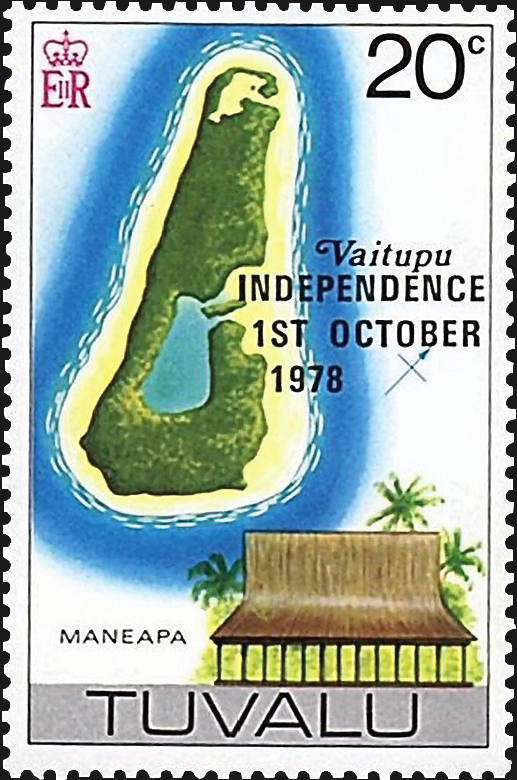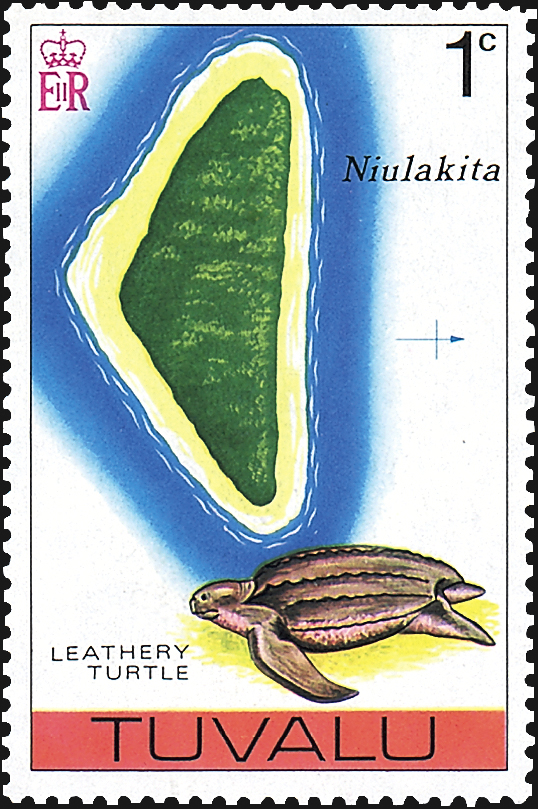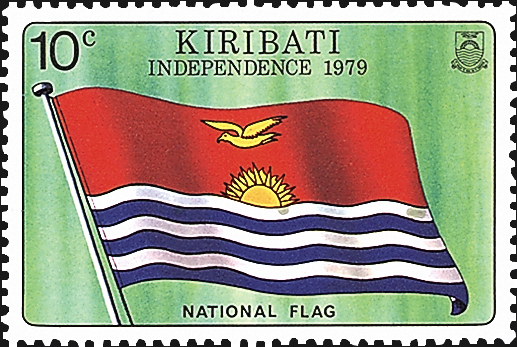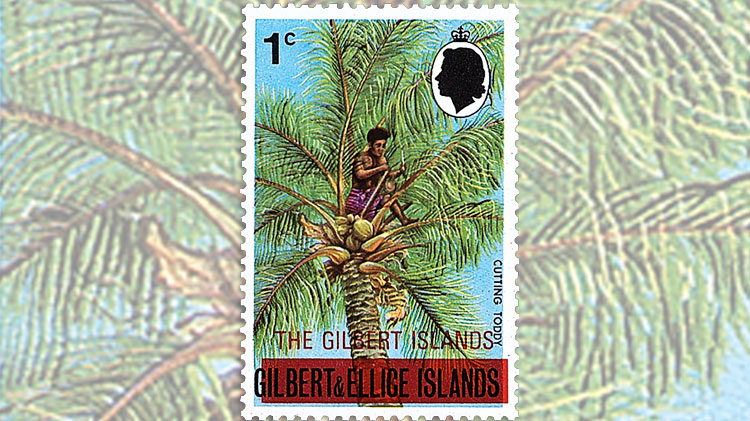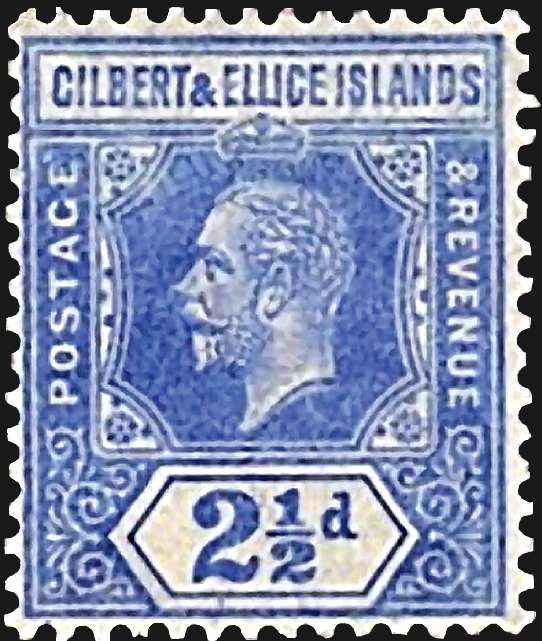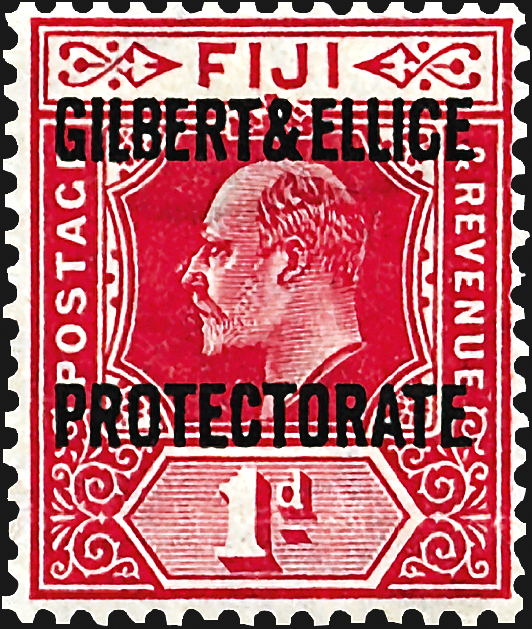World Stamps
Stamps document Gilbert & Ellice Islands’ geopolitical history
By Janet Klug
The Gilbert & Ellice Islands consisted of 37 coral atolls and islands scattered over two million square miles in the western South Pacific Ocean, northeast of Australia.
The islands were once a British Protectorate, then a British Crown Colony and, finally, two independent republics that were renamed Kiribati (former Gilbert Islands) and Tuvalu (former Ellice Islands).
From our viewpoint as collectors, one interesting aspect of these geopolitical changes is that each transformation can be documented with postage stamps.
Gilbert & Ellice Islands’ first stamps coincided with the establishment of its first post office in 1911, and were Fiji key type issues of King Edward VII that were overprinted “GILBERT&ELLICE/PROTECTORATE.” The overprinted 1-penny stamp, Gilbert & Ellice Islands Scott 2, issued in 1911, is shown here.
Key type is a basic stamp design used for stamp issues of two or more postal entities, usually differing in the country name and inscription of value. Key type stamps were used in many of the British colonies, with the basic design modified for the issuing colonies.
King Edward VII’s image was the central vignette. A banner at the top of the stamp was left empty as was a hexagon tablet at the bottom of the stamp. In a separate printing, the banner at the top received the name of the colony that would use the stamps, and the tablet at the bottom was printed with the proper denomination.
The Fiji key type stamps that became Gilbert & Ellice Islands Scott 1-7 originally were produced in 1903 as part of a set of 10 (Fiji Scott 59-69). The Gilbert & Ellice overprint was added by De La Rue & Co.
In 1916, Gilbert & Ellice Islands became a British crown colony. The difference in status between British protectorate and British crown colony is significant.
A British protectorate is a separate territory that, by treaty, is ruled by the British monarch. A British crown colony is ruled by a governor appointed by the monarch.
The first stamps issued for Gilbert & Ellice Islands as a crown colony (Scott 16-17) were King George V key types with the colony’s name at the top and the denomination within the hexagon at the bottom of the stamp. The 2½-penny King George V stamp (Scott 17) issued by Gilbert & Ellice Islands in 1916 is illustrated nearby.
The Gilbert Islands, comprising Gilbert Island, Line Island, Ocean Island and Phoenix Island, separated from the Ellice Islands in 1975, remaining a crown colony but with self-governing status.
On Jan. 2, 1976, overprinted Gilbert & Ellice Islands stamps were issued for Gilbert Islands. Illustrated is a 1¢ stamp overprinted “THE GILBERT ISLANDS” (Scott 253). A red bar across the bottom of the stamp obliterates the original “GILBERT&ELLICE ISLANDS.”
Gilbert Islands stamps continued to be produced through 1979, when the colony became an independent republic named Kiribati.
The republic’s first stamp (Scott 325), issued July 12, 1979, proudly proclaims “INDEPENDENCE 1979” above its new national flag.
Meanwhile, the status of the nine Ellice Islands was changing as well. The group remained a crown colony until 1975, when Ellice Islands became a separate British dependency with its own government and was renamed Tuvalu.
Maps of each of the nation’s islands and atolls appeared on Tuvalu’s stamps in 1976.
Shown nearby is a 1¢ stamp with a map of the reef island of Niulakita (Scott 23).
Tuvalu gained independence on Oct. 1, 1978, and marked the occasion by overprinting seven stamps issued in 1976 with the words “INDEPENDENCE 1ST OCTOBER 1978.”
The overprinted stamps are Tuvalu Scott 85-91. The overprinted 20¢ stamp (Scott 88) is shown nearby, with a map of Vaitupu and a maneapa (house).
The geopolitics of faraway Gilbert & Ellice Islands from long ago to the present day is fascinating, and collecting the attractive stamps that document the history and beauty of the islands is equally absorbing. Give it a try!
MORE RELATED ARTICLES
Headlines
-
US Stamps
Oct 7, 2024, 3 PMMcMurtrie dismissed as APS education director following Sept. 21 arrest
-
US Stamps
Oct 7, 2024, 12 PMVasiliauskas named president of Mystic Stamp Co.
-
US Stamps
Oct 6, 2024, 5 PMApgar souvenir card available
-
US Stamps
Oct 6, 2024, 4 PMFirst Continental Congress and U.N. stamps receive Scott catalog numbers
